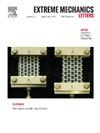Tailoring cell geometry and assembly of modular origami tube for programmable biaxial response under static and impact loads
IF 4.3
3区 工程技术
Q2 MATERIALS SCIENCE, MULTIDISCIPLINARY
引用次数: 0
Abstract
Origami-based architected materials (OAMs) has shown great potential as a rich source to create reconfigurable structures for various applications. However, most existing OAMs are designed for one specific properties in a single direction without considering their global anisotropic mechanical properties. Herein, we propose a novel structural design and assembly strategy of modular origami tube (MOT) with incredibly programmable anisotropic characteristics, aiming to achieve on-demand biaxial response, foldability, and versatility simultaneously along different loading directions. Guided by numerical simulations and experimental tests, we showcase the tunability of biaxial response in MOT units by varying cell geometry and hinge thickness under quasi-static compression. When loaded in the vertical direction, MOT unit exhibits high stiffness and achieves almost 8.3 times peak force value higher than the corresponding data in the lateral direction. It has also been proved that this distinction can be controlled to become smaller or larger by adjusting stiffnesses at vertical and lateral hinges. After strategically assembling various MOT cell units, we developed OAMs structures whose biaxial response can achieve high re-programmability under different impact loading directions, enriching the versatility of such new structural units in designing OAMs structures for multifunctional structural applications.
求助全文
约1分钟内获得全文
求助全文
来源期刊

Extreme Mechanics Letters
Engineering-Mechanics of Materials
CiteScore
9.20
自引率
4.30%
发文量
179
审稿时长
45 days
期刊介绍:
Extreme Mechanics Letters (EML) enables rapid communication of research that highlights the role of mechanics in multi-disciplinary areas across materials science, physics, chemistry, biology, medicine and engineering. Emphasis is on the impact, depth and originality of new concepts, methods and observations at the forefront of applied sciences.
 求助内容:
求助内容: 应助结果提醒方式:
应助结果提醒方式:


